Abstract
Polyaniline/NiO (PANI/NiO) composites were synthesized by in situ polymerization at the presence of HCl (as dopant). FTIR, TEM and XRD were used to characterize the composites. Thermogravimetry (TG)–mass spectrometer (MS) and temperature modulated differential scanning calorimetry (TMDSC) were used to study the thermal stability, decomposition and glass transition temperature (T g) of the composites, respectively. FTIR and XRD results showed that NiO nanoparticles connected with PANI chains in the PANI/NiO composites. TEM results exhibited that the morphologies of PANI/NiO composites were mostly spherical, which were different from the wirelike PANI. TG–MS curves indicated that the products for oxidative degradation of both PANI and PANI/NiO composite were H2O, CO2, NO and NO2. TG curves showed that with NiO contents increased in PANI/NiO composites, thermal stability of PANI/NiO composites increased firstly and then decreased when the NiO content was higher than 66.2 wt%. T g of PANI/NiO composites also increased from 163.19 to 252.36 °C with NiO content increasing from 0 to 50 wt%, and then decreased with NiO content increasing continuously.






Similar content being viewed by others
References
Shirakawa H, Louis EJ, Macdiarmid AG, Chiangand CK, Heeger AF. Synthesis of electrically conducting organic polymers: halogen derivatives of polyacetylene, (CH)x. J Chem Soc Chem Commun. 1977;16:578–580.
Heeger AJ. Semiconducting and metallic polymers: the fourth generation of polymeric materials (Nobel Lecture). Angew Chem Int Ed. 2001;40:2591–611.
Li WG, Jia QX, Wang HL. Synthesis and characterisation of electroactive polyamide with amine-capped aniline. Polymer. 2006;47:23–6.
Xian YZ, Hu Y, Liu F, Xian Y, Wang HT, Jin LT. Glucose biosensor based on Au nanoparticles–conductive polyaniline nanocomposite. Biosens Bioelectron. 2006;21:1996–2000.
Schnitzler DC, Meruvia MS, Hummelgen IA, Zarbin AJG. Preparation and characterization of novel hybrid materials formed from (Ti,Sn)O2 nanoparticles and polyaniline. Chem Mater. 2003;15:4658–65.
Houdayer A, Schneider R, Billaud D, Ghanbaja J, Lambert. Preparation of new antimony (0)/polyaniline nanocomposites by a one-pot solution phase method. J Synth Met. 2005;151:165–74.
Aleshin AN. Polymer nanofibers and nanotubes: charge transport and device applications. Adv Mater. 2006;18:17–27.
Wang SX, Sun LX, Tan ZC, Xu F, Li YS. Synthesis, characterization and thermal analysis of polyaniline (PANI)/Co3O4 composites. J Therm Anal Calorim. 2007;89:609–12.
Yoshimoto S, Ohashi F, Kameyama T. Characterization and thermal degradation studies on polyaniline-intercalated montmorillonite nanocomposites prepared by a solvent-free mechanochemical route. J Polym Sci B. 2005;43:2705–14.
Qi YN, Xu F, Ma HJ, Sun LX, Zhang J, Jiang T. Thermal stability and glass transition behavior of PANI/γ-Al2O3 composites. J Therm Anal Calorim. 2008;91:219–23.
Qi YN, Xu F, Sun LX, Zeng JL, Liu YY. Thermal stability and glass transition behavior of PANI/α-Al2O3 composites. J Therm Anal Calorim. 2008;94:553–7.
Song GP, Han J, Guo R. Synthesis of polyaniline/NiO nanobelts by a self-assembly process. Synth Met. 2007;157:170–5.
Tsocheva D, Zlatkov T, Terlemezyan L. Thermoanalytical studies of polyaniline ‘Emeraldine base’. J Therm Anal Calorim. 1998;53:895–904.
Aracil I, Font R, Conesa JA, Fullana A. TG-MS analysis of the thermo-oxidative decomposition of polychloroprene. J Anal Appl Pyrolysis. 2007;79:327–36.
Onishi A, Thomas PS, Stuart BH, Guerbois JP, Forbes SL. TG-MS analysis of the thermal decomposition of pig bone for forensic applications. J Therm Anal Calorim. 2008;92:87–90.
Jakab E, Mészáros E, Omastová M. Thermal decomposition of polypyrroles. J Therm Anal Calorim. 2007;88:515–21.
Pielichowski K. Kinetic analysis of the thermal decomposition of polyaniline. Solid State Ionics. 1997;104:123–32.
Dash DK, Sahu SK, Nayak PL. Thermal degradation studies of substituted conducting polyanilines. J Therm Anal Calorim. 2006;86:517–9.
Acknowledgements
The authors gratefully acknowledge the financial support for this work from the National Natural Science Foundation of China (No. 2083309, 20873148, 50671098 and U0734005) and the National High Technology Research and Development Program (863 Program) of China (No. 2007AA05Z115 and 2007AA05Z102).
Author information
Authors and Affiliations
Corresponding authors
Rights and permissions
About this article
Cite this article
Qi, Y., Zhang, J., Qiu, S. et al. Thermal stability, decomposition and glass transition behavior of PANI/NiO composites. J Therm Anal Calorim 98, 533–537 (2009). https://doi.org/10.1007/s10973-009-0298-7
Received:
Accepted:
Published:
Issue Date:
DOI: https://doi.org/10.1007/s10973-009-0298-7




